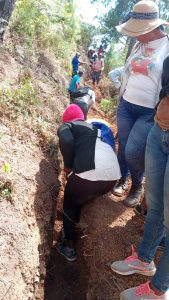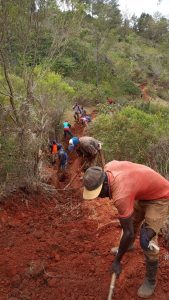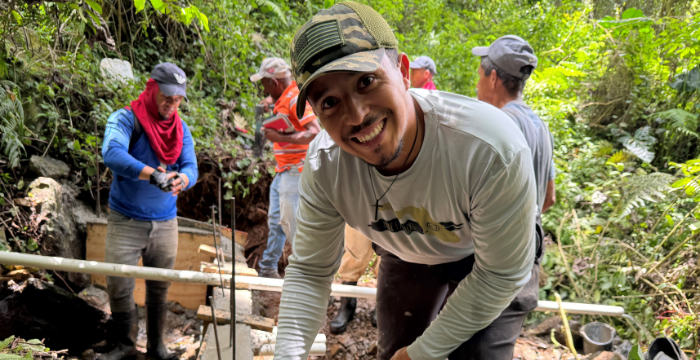DOMINICAN REPUBLIC | It is a dream come true for the villagers of La Cucarita, mission headquarters of the Diocese of Orlando in the Dominican Republic. More than 80 families finally have running water in their homes.
After eight months of searching for a proper spring and trenching pipeline through rugged terrain, everyone rejoiced. The villagers remained steadfast, working tirelessly to overcome all obstacles.
The springhead is a 45-minute brisk walk out of town, into a remote part of the mountains. The townspeople formed assembly lines to carry cement, rebar and plywood planks across the valleys and over rocks to get supplies into the hills. In March they were joined by missioners from Florida Institute of Technology in Melbourne and Embry Riddle Aeronautical University in Daytona Beach.
“Everyone worked together and hard,” recalled engineer Luis José Aybar de los Santos.
For him, the experience was personal. La Cucarita is his hometown. He was educated in mission schools and the Diocese of Orlando helped him earn his degree at the University of Central Florida. He quickly moved back to the mountains to pay it forward, constructing aqueducts and homes in the nearby towns of Las Lajas, Los Frios and La Cueva. And in La Cucarita, his family and friends helped do the same.
“It’s been a super great experience. I’ve met even more of my community. It’s expanded my relationship with them,” he said. “It was weird at first because I had to guide people I’ve known since I was born. It’s something totally new and different.
I had to give orders to my dad on how to do things,” he continued with a laugh. “That’s not something I do every day.”

Aybar de los Santos’ father, Freddy, said it felt good to work with his son. “I am very proud of him. It is what we always wanted. We tried to help form (our children) so they could have the best opportunities and better themselves,” he said. “The water reaches everyone with such strength and pressure. People are experiencing a new reality.”
On Aug. 24 people drenched themselves in a big celebration — the inauguration of the new water system.
“The anticipation and excitement were beyond words. It was the most magnificent experience I’ve had so far,” Aybar de los Santos said. “We were all working so hard. We would leave at 7 a.m. and often get home in the dark. And now we have water in our community. Everyone is super excited.”
Raquel Cespedes, Orlando Diocese mission director, said it was wonderful to see their efforts come full circle.
“The villagers were proud of him and his accomplishments,” she said. “The community really came to accept the reality that Luis José is an engineer. And it was special for him. Now this water is coming to his sister’s house, his mom’s house, his own house that he’s building.”
One resident, Ramón, said, “When I took my first shower, I got such a scare, I almost ran out of the bathroom. The water shot out like a huge, powerful river.”
Karina is Aybar de los Santos’ sister. The 19-year-old worked only a few days on the project, but said, “It makes me happy to have the water coming to our homes. It facilitates so many things.” She noted it is easier to cook, and she doesn’t have to carry water buckets to the bathroom to shower. It’s also easier to do laundry.
“Now that we’re done building the aqueduct, we will pass it to the water committee,” Cespedes said, adding they will collect maintenance fees from the villagers to cover future repairs. The committee includes two trained plumbers, so the village is self-sufficient.
 “This was more than just the completion of a project; it was a testament to the strength and unity of the La Cucarita community,” Cespedes said. “This water project is not just a pipeline. It’s a symbol of hope, perseverance, and the power
“This was more than just the completion of a project; it was a testament to the strength and unity of the La Cucarita community,” Cespedes said. “This water project is not just a pipeline. It’s a symbol of hope, perseverance, and the power
of coming together for a common cause.”
Looking ahead she said the mission hopes to facilitate three more aqueducts in the mountain towns of Los Guayuyos, El Corozo, and El Recodo while providing ongoing support to mission students in Central Florida Catholic schools and the University of Santo Domingo.
To learn more about mission trips to our sister Diocese of San Juan de la Maguana in the Dominican Republic, email Zwamy Parra or to make a donation, click here.
Click here to watch a brief video of the story in action.
By Glenda Meekins of the Florida Catholic staff, September 12, 2024

